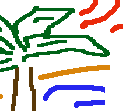
 Home
Home
 Contact Us
Contact Us
 |
Middle East International Services | Commerce | Almusaafer | Higher Education |
| Language Services | Arabic Course | Resource Center | ||
 Home
Home
 Contact Us
Contact Us
|
||||
 Egypt Country Profile
Egypt Country Profile
 | Press to go back to: |
Discover a land of endless fascination, and a culture that has endured for over 5,000 years.
Geography
Location: Northern Africa, bordering the Mediterranean Sea and the Red Sea, between Sudan and Libya. Sinai is an Egyptian territory to the North East in the continent of Asia.
Map references: Africa, Middle East, Standard Time Zones of the World
Area: total area: 1,001,450 km2 land area: 995,450 km2 comparative area: slightly more than three times the size of New Mexico
Land boundaries: total 2,689 km, Gaza Strip 11 km, Israel 255 km, Libya 1,150 km, Sudan 1,273 km Coastline: 2,450 km
Maritime claims: contiguous zone: 24 nm
Continental shelf: 200 m depth or to depth of exploitation exclusive economic zone: not specified territorial sea: 12 nm
Environment: Nile is only perennial water source; increasing soil salinization below Aswan High Dam; hot, driving windstorm called khamsin occurs in spring; water pollution; desertification Note: controls Sinai Peninsula, only land bridge between Africa and remainder of Eastern Hemisphere; controls Suez Canal, shortest sea link between Indian Ocean and Mediterranean; size and juxtaposition to Israel establish its major role in Middle Eastern geopolitics
People
Population: 59,585,529 (July 1993 est.)
Population growth rate: 2.3% (1993 est.) note: the US Bureau of the Census has lowered its 1993 estimate of growth to 2.0% on the basis of a 1992 Egyptian government survey, whereas estimates of other observers go as high as 2.9%
Birth rate: 33 births/1,000 population (1993 est.) Death rate: 9 deaths/1,000 population (1993 est.)
Infant mortality rate: 78.3 deaths/1,000 live births (1993 est.)
Life expectancy at birth: total population: 60.46 years male: 58.61 years female: 62.41 years (1993 est.) Total fertility rate: 4.35 children born/woman (1993 est.)
Nationality: noun: Egyptian(s) adjective: Egyptian
Ethnic divisions: Eastern Hamitic stock 90%, Greek, Italian, Syro-Lebanese 10% Religions: Muslim (mostly Sunni) 94% (official estimate), Coptic Christian and other 6% (official estimate)
Languages: Arabic (official), English and French widely understood by educated classes Literacy: age 15 and over can read and write (1990)
Labor force: 15 million (1989 est.) by occupation: government, public sector enterprises, and armed forces 36%, agriculture 34%, privately owned service and manufacturing enterprises 20% (1984) note: shortage of skilled labor; 2,500,000 Egyptians work abroad, mostly in Saudi Arabia and the Gulf Arab states (1988 est.)
Other:
Local time...GMT + 2 ; 1 May-30 Sep..GMT+3
Telephone Country code...+20
Currency...Egyptian pound(EGP)3.40 = $1.00 (fluctuating)
CAPITAL: Cairo
LANGUAGE: Arabic. English and French are also spoken.
PUBLIC HOLIDAYS: JAN 1 New Years Day; JAN 7 Coptic New Year; APRIL 25 Sinai Day; May 1 Labor Day; JUNE 18 Evacuation Day; JULY 23 National Day; OCT. 6 Armed Forces Day. Muslim religious holidays are observed throughout the year (dates, based on the lunar calendar, vary)
ELECTRICITY: In most of Egypt, 220 volts/50 cycles AC. In some hotels and specific locations, 110 volts/60 cycles is also available.
TIPPING: Tipping is expected for all services. In restaurants, a 10 to 12% service charge is included in the bill, but an additional 10% should be left as well. Tip taxi drivers 10% of the fare; porters 25 piasters per bag. For any and all small services, 25 to 50 piasters.
CLIMATE: Sunny, hot, and very dry; most of Egypt has an annual rainfall of only 1 to 2 inches. The noon temperature in summer can reach 110 to 120 degrees f (43 to 49 c), dropping sharply after sunset, so that evenings are more comfortable. The winters (November to March) are pleasant with clear sunny days and cool, sometimes chilly, nights. During April and May, hot wind storms called Khamsins blow in from the south, filling the air with sandy dust.Desert; hot, dry summers with moderate winters Terrain: vast desert plateau interrupted by Nile valley and delta Natural resources: petroleum, natural gas, iron ore, phosphates, manganese, limestone, gypsum, talc, asbestos, lead, zinc Land use: arable land: 3% permanent crops: 2% meadows and pastures: 0% forest and woodland: 0% other: 95% Irrigated land: 25,850 km2 (1989 est.)